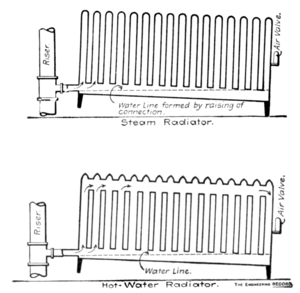considerable amount of air, and it is necessary to provide means for venting the piping and radiators so as to allow it to escape in the proper way. Ordinarily, when steam is shut off from a radiator it fills with air at atmospheric pressure, through the air valve; and when steam is turned on, this air must in some way be allowed to escape before all of the surface can have full heating effect. The rapidity with which the air will be displaced by the steam depends on where the air valve is placed and on the design of the radiator. In some radiators the air will flow out the air valve and be followed up by the steam rapidly and uniformly; while in others the air will pocket in places, and it may be hours before it all works out. The action of radiators in this regard is very peculiar, and it is frequently exceedingly difficult to predict beforehand whether or not a radiator will allow good circulation.
As a general thing the simplest radiators are the most effective. Air is heavier than steam of the same pressure, but in a heating system the air will always find its way to the dead end, or point where there is no circulation. If a straight, vertical pipe, closed at the top, be connected to a source of steam supply, any air in the system will accumulate at its top. If steam is turned on

